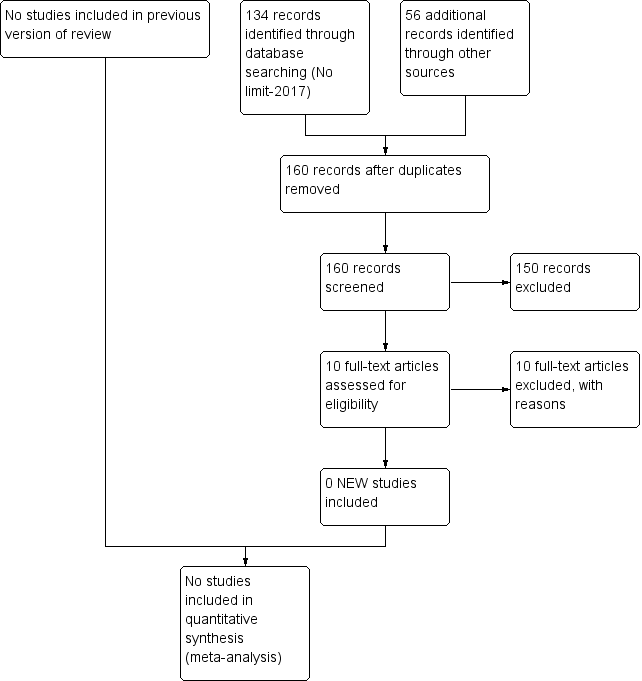| Study | Stage of extravasation | Intervention | Outcome | Reason for exclusion |
| Casanova 2001 | Skin necrosis (stage 3): n = 3 Swelling, oedema, discolouration (stage 1‐2): n = 11 | Hyaluronidase and aspiration ‐ 12 cases Hyaluronidase infiltration alone ‐ 1 Saline irrigation and aspiration ‐ 1 Treatment allocation not specified by stage of injury | No sequelae | Neither a randomised nor a quasi‐randomised study |
| Chen Y Y 1996 | Swelling, erythema, and induration (stage 3): n = 1 | Hyaluronidase and saline irrigation | No sequelae | Neither a randomised nor a quasi‐randomised study |
| Chowdhury 2004 | Erythema and oedema (stage 1‐2): n = 12 Skin necrosis (stage 3): n = 24 | Stage 1‐2 ‐ standard wound management Stage 3 ‐ hyaluronidase and saline irrigation | No sequelae No sequelae | Neither a randomised nor a quasi‐randomised study |
| Davies 1994 | Skin necrosis (stage 3): n = 2 | Hyaluronidase and saline irrigation | Minimal scarring, no sequelae | Neither a randomised nor a quasi‐randomised study |
| Gault 1993 | Skin necrosis (stage 3): Early referral: n = 44 Delayed referral (stage 3‐4): n = 52 | Stage 3: Saline irrigation alone: n = 37 Liposuction and saline irrigation: n = 6 Liposuction alone: n = 1 Stage 3‐4: Wound debridement and surgical flap | No sequelae 8 (15%) healed without tissue necrosis, 17 (33%) minor skin sloughing, 27 (52%) extensive damage to tissues ‐ 3 amputations | Neither a randomised nor a quasi‐randomised study |
| Harris 2001 | Exact stage of extravasation injury not specified: n = 56 | Saline irrigation | No sequelae | Neither a randomised nor a quasi‐randomised study |
| Kostogloudis 2015 | Stage 3 and stage 4 extravasation | Saline irrigation within 30 minutes of extravasation injury | None of the wounds needed secondary skin coverage procedures | Neither a randomised nor a quasi‐randomised study |
| Kuensting 2010 | Discolouration, oedema, cool, pulses not palpable (stage 4): n = 1 | Infiltration with recombinant human hyaluronidase (rHuPH20) | No sequelae | Neither a randomised nor a quasi‐randomised study |
| Martin 1994 | Oedema, pallor, cold, and no capillary filling | Infiltration with hyaluronidase, liposuction, and saline irrigation | No sequelae | Neither a randomised nor a quasi‐randomised study |
| Siu 2007 | Skin necrosis (stage 3): n = 1 | Hyaluronidase and saline irrigation | No sequelae | Neither a randomised nor a quasi‐randomised study |


